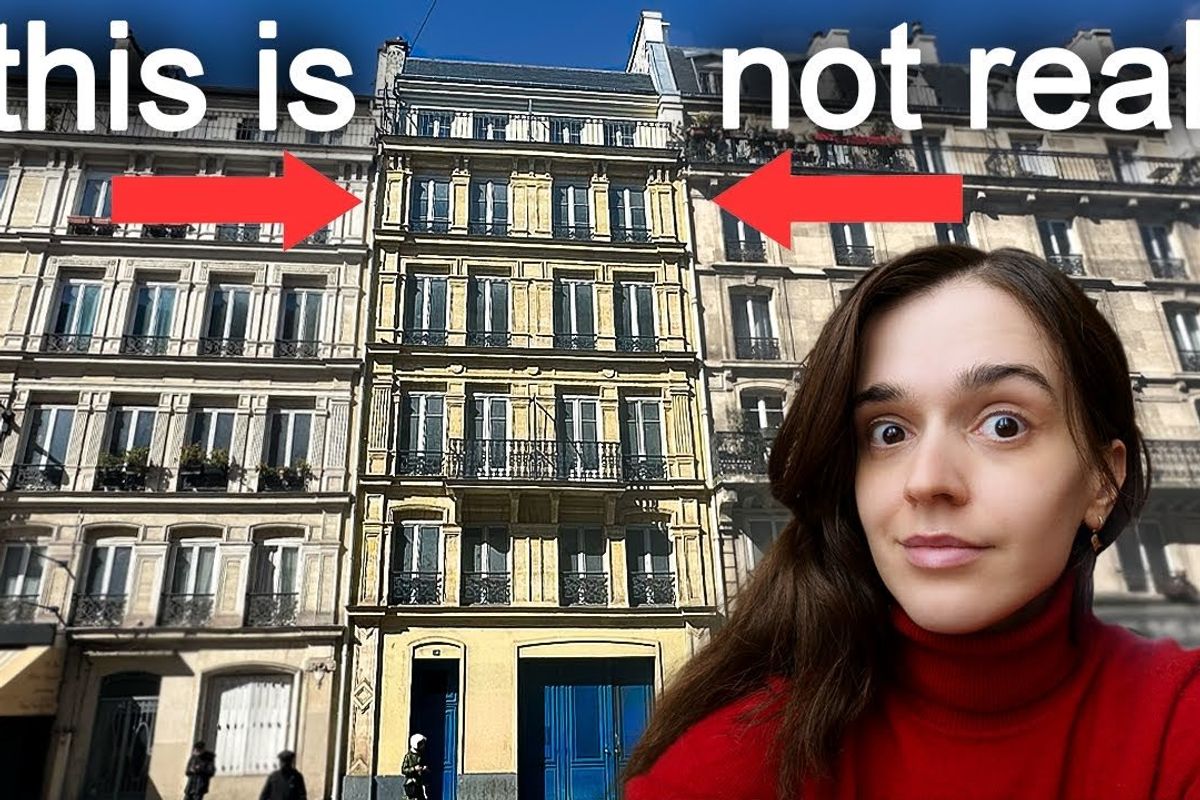French cultural expert shares Paris' biggest secret: Many buildings are fake
"As normal people, you have no idea."

French YouTuber Lucile.
One reason people fall in love with Paris when they see it for the first time is that it looks exactly as it does in the movies or photographs. It is romantic, charming, and effortlessly beautiful, with its elegant boulevards, old stone buildings, cozy cafés, and iconic landmarks like the Eiffel Tower and the Arc de Triomphe.
A significant reason why Paris is so absorbing is that it is architecturally consistent, and the city and its citizens put a great deal of effort into maintaining that consistency. In a new video by Lucile, a French woman who creates cultural commentary videos about Paris and French culture, the city even goes so far as to create “fake” buildings to maintain its consistently beautiful appearance. "A lot of the fake buildings in Paris really blend in nicely with their surroundings and are so hard to spot. Just by looking at them, it would be impossible to notice,” Lucile explains.
- YouTubeyoutu.be
In the video, Lucile reveals that one building in her neighborhood appears to be a quaint French apartment building that was once social housing. Still, a little investigation shows that it's actually a massive data center complete with air conditioners on the roof—a rarity in Paris. The A/C units are there because the servers generate an incredible amount of heat.
Another building, 145, rue La Fayette, which has been called the "entrance to the underworld," is holding a secret. The doors are fake, allowing it to blend in with the neighborhood, and the roof is entirely flat. However, in reality, the entire building is actually an air vent for a French Metro.
Fake Facade in Paris hiding a Subway Vent - 145 Rue la Fayette, 75010 Paris, France.
byu/hypersite inarchitecture
Why do a lot of buildings in France have a similar design style? It’s because they underwent a massive redesign in the mid-19th century by an architect named Georges-Eugène Haussmann, a French official who served as prefect of Seine and demolished many of the old, cramped buildings from the Middle Ages. “In 1853, Haussmann came in, and he was basically given full powers to redesign Paris in a better way,” Lucile explains. “So, he went ahead, and he tore down entire neighborhoods and thousands of buildings. And instead, he built the elegant buildings and wide avenues we still have today in Paris. Haussmann really wanted to achieve a uniform look, so he put some really strict rules in place. And this is why a lot of the buildings in Paris look the same—they have the same height, the same façades, and the same balconies. Haussmann's influence on Paris was huge because today, around 60% of all of Paris' buildings are Haussmann-type buildings.”

Lucile also notes that 1972 is an important year for the city because, at a time when it was losing many classic buildings, a proposal for a brutalist block building was made to replace L'Amandier d'Or, a beautiful Haussmann design. "Luckily, people pushed back, and it became a pretty big thing. The French government had to step in, and they blocked the project, requiring the bank to preserve the façade,” Lucile explains. The amusing thing is that if you walk to the back of the preserved façade, it's actually a 1970s office building.
#OTD 27 March 1807 Georges-Eugène Haussmann was born. As prefect of Seine he carried out a massive urban renewal programme of new boulevards, parks & public works which remade Paris. pic.twitter.com/i2c3JgAWZc
— The French History Podcast 🇲🇫 (@FrenchHist) March 27, 2022
“This was one of the first times that Paris did the fake buildings,” Lucile says. “A lot of people wish they had kept the original building and renovated everything, not just the front. But, some other people think it's a great way to keep Paris’s charm while making room for more modern buildings. And wherever you stand, either way, this building set the trend.”
There’s something very satisfying about learning that there is a small amount of artifice in keeping Paris’s magical charm, like the false-front buildings you see at Disneyland or on a film set. But there’s something even more wonderful to know that the people of Paris, and its leaders, put so much effort into preserving its incredible ambiance.



 TikTok · Ale
TikTok · Ale
 Kittens are the cutest.
Kittens are the cutest.  Grrrr, wook at his widdle paws and his widdle whiskers.
Grrrr, wook at his widdle paws and his widdle whiskers. 

 Design 3D GIF
Design 3D GIF 
 Bluebells at the Brooklyn Botanical Gardens.
Bluebells at the Brooklyn Botanical Gardens. 